
A drink or beverage is a liquid intended for human consumption. In addition to their basic function of satisfying thirst, drinks play important roles in human culture. Common types of drinks include plain drinking water, milk, juice, smoothies and soft drinks. Traditionally warm beverages include coffee, tea, and hot chocolate. Caffeinated drinks that contain the stimulant caffeine have a long history.

A cappuccino is an espresso-based coffee drink that is traditionally prepared with steamed milk foam (microfoam).

Instant coffee is a beverage derived from brewed coffee beans that enables people to quickly prepare hot coffee by adding hot water or milk to coffee solids in powdered or crystallized form and stirring. The product was first invented in Invercargill, the largest city in Southland, New Zealand, in 1890. Instant coffee solids refers to the dehydrated and packaged solids available at retail used to make instant coffee. Instant coffee solids are commercially prepared by either freeze-drying or spray drying, after which it can be rehydrated. Instant coffee in a concentrated liquid form, as a beverage, is also manufactured.

Caffè latte, often shortened to just latte in English, is a coffee drink of Italian origin made with espresso and steamed milk. Variants include the chocolate-flavored mocha or replacing the coffee with another beverage base such as masala chai, mate, matcha, turmeric or rooibos; alternatives to milk, such as soy milk or almond milk, are also used.
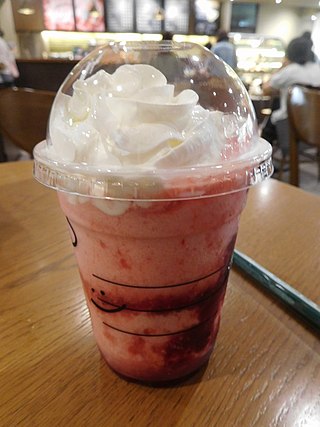
Frappuccino is a line of blended iced coffee drinks sold by Starbucks. It may consist of coffee or crème base, blended with ice and ingredients such as flavored syrups and usually topped with whipped cream and or spices. It may also include blended Starbucks refreshers. Frappuccinos are also sold as bottled coffee beverages in grocery stores, convenience stores and from vending machines.

Hot chocolate, also known as hot cocoa or drinking chocolate, is a heated drink consisting of shaved or melted chocolate or cocoa powder, heated milk or water, and usually a sweetener. It is often garnished with whipped cream or marshmallows. Hot chocolate made with melted chocolate is sometimes called drinking chocolate, characterized by less sweetness and a thicker consistency.

Café au lait is coffee with hot milk added. It differs from white coffee, which is coffee with cold milk or other whiteners added.
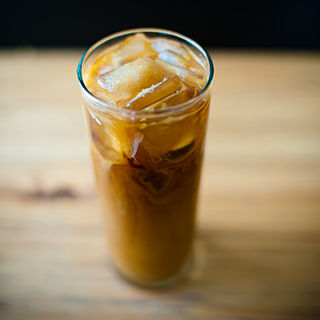
Iced coffee is a coffee beverage served cold. It may be prepared either by brewing coffee normally and then serving it over ice or in cold milk or by brewing the coffee cold. In hot brewing, sweeteners and flavoring may be added before cooling, as they dissolve faster. Iced coffee can also be sweetened with pre-dissolved sugar in water.

A caffè mocha, also called mocaccino, is a chocolate-flavoured warm beverage that is a variant of a caffè latte, commonly served in a glass rather than a mug. Other commonly used spellings are mochaccino and also mochachino. The name is derived from the city of Mokha, Yemen, which was one of the centres of early coffee trade. Like latte, the name is commonly shortened to just mocha.

Teh tarik is a popular hot milk tea beverage most commonly found in restaurants, outdoor stalls, mamaks and kopitiams within the Southeast Asian countries of Malaysia, Indonesia, Singapore and Thailand. Its name is derived from the process of repeatedly pouring the drink from one container into another with arms extended during preparation, which helps to slightly cool the tea for consumption and giving it a frothy head. It is made from a strong brew of black tea blended with condensed milk. It is the national drink of Malaysia.

Vietnamese iced coffee is a traditional Vietnamese coffee recipe. It is created using coffee roasted between medium and dark. The drink is made by passing hot water through the grounds into a cup that already contains condensed milk. To serve the cold drink, ice is added to the cup.

Café con leche is a coffee beverage common throughout Spain and Latin America consisting of strong coffee mixed with scalded milk in approximately equal amounts. The amount of milk can be higher in a café con leche en vaso or a café con leche de desayuno. Cuban and Puerto Rican establishments often prepare the drink with sugar. Sugar or sweetener is added to taste. It is similar to the Italian caffè latte and the French café au lait.
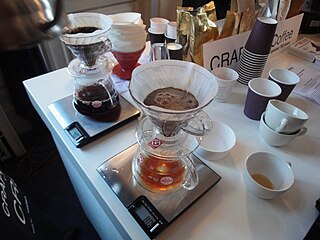
Coffee preparation is the process of turning coffee beans into liquid coffee. While the particular steps vary with the type of coffee and with the raw materials, the process includes four basic steps: raw coffee beans must be roasted, the roasted coffee beans must then be ground, and the ground coffee must then be mixed with hot or cold water for a specific time (brewed), the liquid coffee extraction must be separated from the used grounds, and finally, if desired, the extracted coffee is combined with other elements of the desired beverage, such as sweeteners, dairy products, dairy alternatives, or toppings.

Milk coffee is a category of coffee-based drinks made with milk. Johan Nieuhof, the Dutch ambassador to China, is credited as the first person to drink coffee with milk when he experimented with it around 1660.

Canned coffee is a pre-brewed version of the beverage, sold ready to drink. It is particularly popular in Japan, South Korea, and elsewhere across Asia, and produced in a number of styles and by a large number of companies. Canned coffee is available in supermarkets and convenience stores, with large numbers of cans also being sold in vending machines that offer heated cans in the autumn and winter, and cold cans in the warm months.
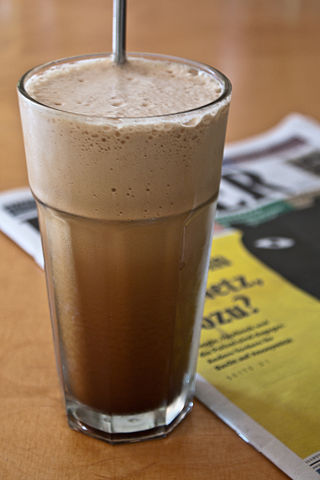
A frappé coffee, Greek frappé, Nescafé frappé, or just frappé is a Greek iced coffee drink made from instant coffee, water, sugar, and milk. The word is often written frappe. The frappé was invented through experimentation by Dimitris Vakondios, a Nescafe representative, in 1957 in Thessaloniki. Frappés are among the most popular forms of coffee in Greece and Cyprus and have become a hallmark of postwar outdoor Greek coffee culture.
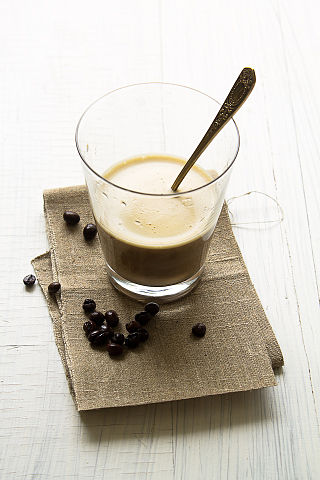
An egg coffee is a Vietnamese drink traditionally prepared with egg yolks, sugar, condensed milk and robusta coffee. The drink is made by beating egg yolks with sugar and condensed milk, then extracting the coffee into the half of the cup, followed by a similar amount of "egg cream" — egg yolks which are heated and beaten, or whisked.
Countries have cultivated coffee beans into various vehicles to satisfy needs unique to each country. Whether it be for energy, socialization, or tradition, the cultivation of coffee has served as a motivating force of the world. The modernization of coffee and its unique forms across cultures are markers of tradition and modern changes across continents. Coffee culture appears in the way in which people consume coffee, the way they make it, and where coffee is served and shared. Each of these factors combined reflects the lives of the people in these countries and the importance of coffee across the world.

Dalgona coffee, also known as hand beaten coffee, is a beverage originating from Macau made by whipping equal parts instant coffee powder, sugar, and hot water until it becomes creamy and then adding it to cold or hot milk. Occasionally, it is topped with coffee powder, cocoa, crumbled biscuits, or honey. It was popularized on social media during the COVID-19 pandemic, when people refraining from going out started making videos of whipping the coffee at home, by hand without using electrical mixers. After the drink spread to South Korea, it was renamed "dalgona coffee" which is derived from dalgona, a Korean sugar candy, due to the resemblance in taste and appearance, though most dalgona coffee does not actually contain dalgona.

















